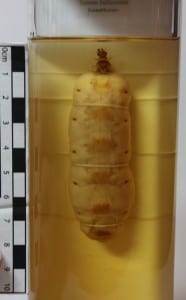Specimen of the Week: Week 177
By Will J Richard, on 2 March 2015
 Hello Grant-fans. Will Richard here. Bringing you this week’s specimen. And just like last time (and the time before etc.) the dilemma is… what to choose? So far I’ve reported on three mammals and a bird. All full of backbone.
Hello Grant-fans. Will Richard here. Bringing you this week’s specimen. And just like last time (and the time before etc.) the dilemma is… what to choose? So far I’ve reported on three mammals and a bird. All full of backbone.
So, I suppose I’ll have to bite the bullet, but not the bullet ant, and give a nod to the better half (more like nine and a half tenths) of the animal kingdom.
The invertebrates.
This week’s specimen of the week is…
**The preserved termite queen (Macrotermes bellicosus)**
1) God save the Queen
This monster bug is the preserved body of an adult, breeding female, or queen. For her species, which is one of the largest known, she is actually relatively small – measuring just under 8cm. Other queens nearly half as big again have been recorded. A fecund queen such as this specimen can lay up to 40,000 eggs a day and acts as the reproductive engine driving a colony’s development. Some queens can live for 25 years. So that’s 40,000 eggs a day for 25 years, giving us a maximum production of 365,250,000 eggs by a single individual. One colony can contain millions of insects (now I know why!) though all colonies are founded by just two: our egg factory of a queen and a “king” who fertilises what she lays.
2) Of the termite regime
They are eusocial insects. This means they have overlapping adult generations, share responsibility for parental care and have a clear division of labour between the reproductive and the non-reproductive individuals. There is variation in social structure depending on the species but Macrotermes bellicosus has five castes: the reproductives, the workers, minor and major soldiers and nymphs. Most of them are named appropriately: workers work, soldiers fight, and reproductives reproduce. Nymphs on the other hand are slightly more complex. All the others are “terminal stages”, once you become a worker or a soldier that is how you stay, but nymphs retain a degree of developmental flexibility and act as a reserve for emergency reproduction or dispersal.
3) Another one bites the (saw)dust
In Macrotermes bellicosus two distinct feeding strategies have been identified. Some workers were found to eat and digest plant matter directly – leaf munching – whereas others were found to digest fungus from the “fungus comb”. This is where it gets more interesting. In what can only be considered basic agriculture, the termite colony constructs comb-like structures from their own fecal matter (which is rich in carbohydrates) to cultivate the growth of fungus upon which they then feed. It seems that this provides the majority of a colony’s nutrition. In fact, nothing is wasted in termite society, alongside growing food from their poo, hard to find nutrients are recycled by selective cannibalism. They will eat discarded skins, the dead and also feed on sick or injured individuals… Bleak times.
4) Mound Everest
Termites are famous for their engineering prowess and Macrotermes bellicosus is no different. They are responsible for some of the largest termite mounds ever recorded, producing tapering skyscrapers up to nine metres high. Their nest begins underground but workers create their own cement (from sand, clay and saliva) which they compact to form the walls. The temperature and humidity within the mound are constant as the termites develop and regulate their own micro-climate all with the aim of providing the optimal environment for both termite and fungal growth. This is so successful that ambient temperature fluctuations of 35oC have been shown to cause a change of less than 2oC around the 30oC ideal within the nest.

Termite mound, Ghana, West Africa. Image by Shawn Zamechek CC-BY-2.0 via Wikimedia Commons
These master builders are also known to moderate their designs, maximising ventilation in hot climates and insulation in cooler ones. In hotter temperatures the colony will build a taller mound, with a ridged surface (to maximise the available surface area for heat-exchange) and thin walls that are filled with ventilation channels. Interestingly, as the temperature falls towards the end of the day, workers will close these channels to increase the mound’s heat-retention through the night. In cooler habitats mounds will be smaller and domed, with much thicker walls lacking in ridges or channels.
5) So, how do they do it?
A single termite is stupid. So how can the colony show such ingenuity? This phenomenon is known as “swarm intelligence” whereby the community is clever even though the individual is not. Each termite is following simple rules based on local stimuli, there is no single individual seeing the bigger picture (not even our queen) but by the repetition of these simple “decisions” across millions of individuals the colony, as a whole, is capable of some relatively complex processing. And once the decision is made there is no lack of dumb muscle to get the job done.
References:
Hinze, B., Crailsheim, K., Leuthold, R.H.; 2002; Polyethism in food processing and social organisation in the nest of Macrotermes bellicosus (Isoptera, Termitidae); Insectes Sociaux; Volume 49; Issue 1; pp 31-37
Bandiya, H. M., Majeed, Q., Ibrahim, N. & Yahaya, M. Y. a. M.; 2013; Intra-colonial Population of Macrotermes bellicosus (Smeathman) [Isoptera: Termitidae] in Sokoto, Semi-Arid Zone of North-Western Nigeria; J. Basic Appl. Sci.; 21 (1); 55-59
various authors edited by Vega F. E., Blackwell, M.; 2005; Insect-Fungal Associations: Ecology and Evolution; Oxford University Press
Korb, J; 2003; Thermoregulation and ventilation of termite mounds; Naturwissenschaften; 90; 212–219
Will Richard is Visitor Services Assistant at the Grant Museum of Zoology
One Response to “Specimen of the Week: Week 177”
- 1
 Close
Close



[…] Download Image More @ blogs.ucl.ac.uk […]